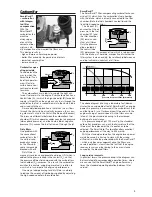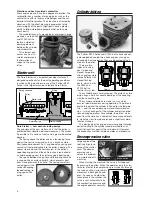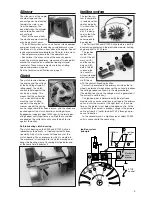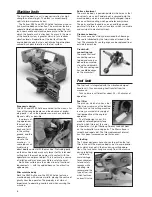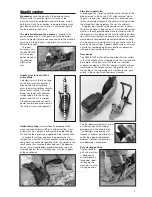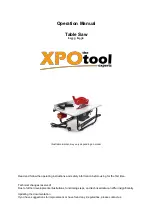
Peripheral speed
Peripheral speed is measured in
metres per second and is directly
proportional to engine speed. By
definition, peripheral speed is the
speed at which a given point on
the blade’s circumference travels
through the air. It is also the
speed which a given diamond
segment, for instance, has in relation to its point of con-
tact during cutting. Another way of looking at the term
“peripheral speed” is to imagine a cutting machine as a
moving vehicle with the cutter blade as the driven wheel.
A speed of 5,100 rpm with a 300 mm cutter blade would
give the following speed:
Blade circumference: 0.3 m
× π
= 0.94 m
Blade speed: 5,100 rpm = 85 r/s
Circumference
×
speed = peripheral speed
Peripheral speed = 0.94 m
×
85 r/s = 80 m/s
Computed into a “vehicle-type situation” this gives a
speed of about 290 km/h!
Partner cutter blades are made for peripheral speeds
of 100 m/s. A European colour code prescribes a green
colour for a maximum peripheral speed of 100 m/s,
while a red colour indicates max. 80 m/s.
BLADE TYPES
Hand-held
power
cutters require
cutting blades
which are
approved for
use in hand-
held machines
– it is not per-
missible to fit
them with bla-
des intended
for fixed-posi-
tion bench-
mounted machines, for example. The speed marking
must match or be higher than the figure on the machine’s
specification plate. Partner cutting blades are naturally
intended for Hand-held cutting.
– The diamond blade
is becoming increasingly common
for cutting concrete, stone, asphalt and similar materials.
The general advantage of the diamond-tipped blade is
that it retains its cutting depth virtually throughout its life
so cutting efficiency remains high. Used correctly, it
offers excellent blade economy.
Partner “PowerCut” diamond blades are available for
professional and occasional users. The range encom-
passes several grades which are selected to suit the
type of material to be cut. Diamond blades are available
for both dry and wet cutting.
– Abrasive discs
, which used to be the norm for cutting
all materials, are now used primarily for cutting metals.
Partner abrasive blades are available for steel and conc-
rete, the concrete blade is also very suitable for cutting
softer steel types such as reinforcing rods and structural
steel.
– Partner Rescue
is a special blade with a TCT hard-
metal cutter. It may only be used by specially trained
personnel in emergency rescue situations.
10
Cutter blades
Specification plate
All Partner power cutters
are equipped with a plate
on the blade guard which
details all the important
specifications needed for
choosing cutter blades.
The dimensions which
the operator needs to
know are the following:
Blade diameter
Blade diameter is given in either
mm or inches.
Three models are available in
the Partner K950 Active range,
with cutting blade sizes 300 mm
(12˝), 350 mm (14˝) and 400 mm
(16˝). Two Partner K1250 Active
models are available, with 350
mm (14˝) and 400 mm (16˝) cutting
blades respectively.
Centre diameter
The cutter blade’s fitting holes
must exactly match the bushing
diameter on the spindle shaft.
Various standards are available
depending on the countries in
which the machines are sold.
The most common standards are
20.0, 22.2, 25.4 (1˝ ) and 30.5 mm.
Bushings for Partner Power Cutters
are available for these diameters
and can be replaced.
Speed
All cutter blades are marked
with a speed which is usually
measured in revs per minute
(rpm) and which indicates the
rotating speed which should not
be exceeded. The blade’s maxi-
mum speed is determined by the
blade manufacturer.
The Power Cutters plate also indicates a speed which
is determined by the machine manufacturer and which is
termed the “nominal speed”.
The nominal speed is the speed which is stated on the
machine plate and which determines which marking the
blade must have in order to be used with the machine.
The cutter blade should be marked with the same or
higher speed than that specified on the machine plate.
The maximum speed of the machine is a rating which
does not affect the machine operator, so it is not speci-
fied on the machine but it is used, for instance, as a
control parameter at the service workshops. The maxi-
mum speed is the highest permitted speed which the
spindle shaft is allowed to achieve with an unloaded
blade and the engine running at full throttle.
According to the European norm, the maximum speed
may not exceed the nominal speed specified on the
machine by more than 10%. For example, a machine
with the nominal speed of 5,100 rpm should never
exceed a max. speed of 5,100
×
1.1 = 5,610 rpm.
rpm
m/s



